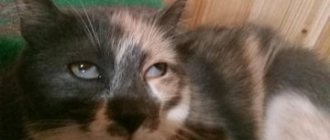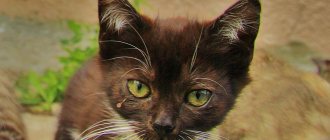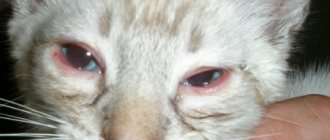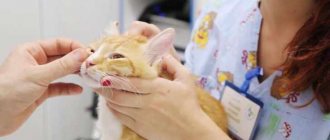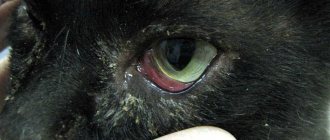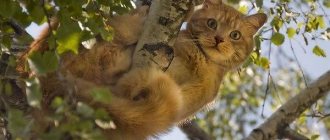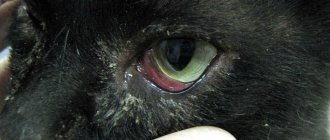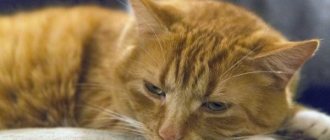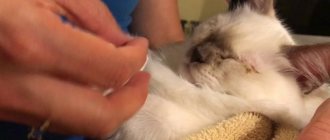For what reasons does the disease appear?
The detection of a white film on the eyes of cats or the third eyelid, the formation of purulent discharge, swelling: indicates that the fluffy cat has obvious problems with the visual apparatus. Such violations can be detected for all sorts of reasons:
- for various conjunctivitis;
- due to mechanical impact;
- with entropion of the eyelids (entropion) – Maine Coons, British, Persians and Scottish Folds are at risk;
- if you are allergic to various irritants;
- with corneal necrosis;
- as a result of chemical exposure to the mucous membrane of the visual organ;
- if the fluffy has microparasites (internal or external);
- if there are problems in the functioning of the gastrointestinal tract and other organs;
- if the mustache is bothered by internal diseases (bacterial, viral or fungal);
- due to the formation of tumors (adenomas).
You should know that the cat's third eyelid is a necessary part of the visual apparatus in whiskers, which performs a protective function: to prevent infection from entering the mucous membrane of the eye and as a kind of barrier that softens the effects of mechanical damage.
This whitish or bluish eye membrane is practically invisible when looking at the barbel. You can notice it when the purr bends its head towards the floor or begins to blink, then a thin film completely covers the entire eye.
This action helps the mustache get rid of excess dust particles, and also promotes the distribution of tear fluid inside the eyelid.
If the third eyelid falls out or a film becomes visible on one or both eyes in cats, then it is necessary to determine the root of the problem and begin treatment immediately.
Description of the pathology
Rhythmic, oscillating eye movements are called nystagmus. As a rule, they move exclusively in the horizontal plane. Vertical nystagmus is much less common... and is almost always a symptom of serious brain damage. Thus, nystagmus may be a normal physiological response or the result of pathology.
Why does it even arise, what do these erratic movements of the eyeballs mean? The eyes play a very important role in maintaining the balance of the body in space. They are directly connected to other organs of the vestibular apparatus. We can say that the brain checks the “sensor readings” by comparing information from the vestibular system with the data it receives from the eyes. Such a complexly organized system allows cats to maintain balance in any conditions. Judging by the number of comparisons between dexterous people and cats, the animal body is fully capable of this.
Unfortunately, nothing is perfect in the world, and therefore even such a system can be overloaded with information and “fooled.” You yourself could encounter this by going too far with visiting carousels. The fact is that the brain and all analyzers adapt to constant rotation, and by inertia they continue to “feel” it even after the attraction has already stopped. At this moment, if you look at the person, you can see classic nystagmus. But why does this phenomenon occur in cats? They don't ride on carousels, do they?!
External manifestations of the disease
The presence of a third eyelid in a mustache is signaled not only by a change in the cat’s appearance, but also by changes in its behavior:
- the purr begins to hide from bright lighting;
- she endlessly rubs her muzzle with her paws, including her eyes;
- The pet feels discomfort, so it often blinks and squints its eyes.
At the same time, you can see profuse lacrimation in your pet, possibly the presence of pus and a change in the shade of the mucous membrane to red. If you do not help the tailed creature, there is a high probability of vision loss.
Loss of the third eyelid in a pet is not always a dangerous sign; in old cats this phenomenon is common, which is explained by age-related changes (weight loss, sunken eyes). In any case, the best solution would be to consult a specialist.
Causes of the disease
A disease in which a cat's eyes are half covered with a film is not so rare. The filmy layer on the surface of a cat's eyelids (on the inside) in most cases is white. Sometimes it covers a significant part of the animal's eye. It doesn’t look pretty, and the pet’s well-being worsens. Therefore he should be helped. To overcome a disease in which your pet's eyes are half covered with a film, you need to know the causes of the pathological condition.
The third eyelid (this is the name given to the film that covers a cat’s eyes) is the conjunctiva. It covers the surface of the eyelids (lower and upper), as well as the eyeball. In cats, in the inner corners of the eyes there is a fold of the conjunctiva (nictitating membrane). It ensures the full functioning of the visual organ.
It is impossible to see the fold with fully open eyes (if they are healthy). It becomes noticeable only when the animal squints its eyes or blinks. The nictitating membrane helps
:
- proper distribution of tear fluid;
- removal of foreign elements from the surface of the visual organ (for example, dust, grains of sand);
- producing up to 1/3 of tear fluid.
If a cat’s fully open eyes suddenly become half covered with a film, this indicates the development of negative processes in the animal’s body. There are many topics on veterinary forums about the appearance of a film on a cat’s eyes. This pathology is associated with prolapse of the 3rd eyelid. It occurs due to swelling of the nictitating membrane, the functions of which are impaired. The animal's eyes do not receive the required amount of moisture, so they become more vulnerable to negative factors.
The opposite situation may also arise when the visual organ of a pet suffers from excess moisture. There are many reasons why a cat's third eyelid may fall out. In fact, this pathology is not the main disease. This is more likely a sign of another disease. For example
:
If you notice that a film has begun to appear on your pet cat's eyes, take the animal to the veterinarian as soon as possible. Timely diagnosis and proper treatment will help avoid re-infection and quickly restore the health of your furry pet. Using an ophthalmoscope, a specialist will quickly find out the cause of eye inflammation and offer a high-quality and effective course of treatment. If it turns out that the film on the cat’s eyes is due to cataracts or blockage of the vessels of the visual organ, surgical intervention is performed.
If a kitten's eyes are half covered with a film, this most likely indicates inflammation of the third eyelid. The treatment regimen is developed by a veterinarian on an individual basis. There are many different methods for dealing with unsightly film on a cat’s eyes. Here are the most famous of them
:
- drops or ointments with an anesthetic effect (help relieve inflammation);
- washing the cat's eyes using tea leaves, olive oil, boric acid or regular warm water (the procedure will help remove dust particles from the surface of the visual organ, remove suppuration and increased tearing);
- inclusion of vitamins B 12 in the animal’s diet;
- balanced diet;
- timely prevention.
If you notice that the corners of your cat's eyes are covered with a film, take preventive measures to avoid further spread of the veil on the visual organ. There are good preventive measures to prevent the appearance of a film on a cat’s eyes.
.
- Use a special solution to wash your cat’s eyes (you can use chamomile decoction). Soak a cotton swab in it well, and then gently rinse your pet’s one and other eyes. When you complete the procedure, do not forget to blot the cat's eyes with a dry cotton pad.
- Before starting preventive eye rinsing, wash your hands well with soap to prevent infection from entering the inflamed organ.
- Review your cat's diet, make it more balanced, varied and correct.
Remember that early detection of health problems will avoid questions as to why the cat's eyes are half closed with film. Do not self-medicate under any circumstances; it is better to immediately visit a veterinarian with your pet. He will prescribe adequate treatment that will not cause severe harm to your purr’s body. It will help get rid of film on the eyes and improve the cat’s health.
Pets can bring you many moments of joy and even happiness, but only if they are healthy and well, because a pet in need of emergency medical care is a real nightmare for almost any person. What to do if your beloved cat gets sick? So, in this article we will try to deal with the problem of films that appear on the eyes of cats.
These films can close a cat's eyes halfway, thus, this dangerous disease not only harms your pet, but also looks absolutely terrible. And now a little more detail.
Eye diseases of a pet (especially a cat) are not the rarest thing you can encounter, but treatment may require the help of a veterinarian
, although some diseases can be cured with simple home remedies. What is the name of a disease that has the symptoms listed above in the text?
Yes, that’s right: a disease associated with the appearance of white matter (film) that covers the eye from the inside. Sometimes this film can cover quite a significant part of the animal’s eye.
White film on both eyes is a dangerous sign
If you find a whitish film on one eyelid of a furry cat, then most likely this change occurred due to the entry of a speck or other foreign body. A more dangerous situation is when a film is detected on both eyes of the cat, which is most likely caused by an infectious disease.
Very often, males damage their eyes with their claws during a fight. Wounds that appear on the eyelids can easily become infected.
If there is an infection, a film may form in the eyes of the mustache. Some diseases (keratitis, corneal ulcer, etc.) signal themselves by the appearance of green or white discharge. If such signs are noticed in your pet, then urgently take him to the veterinary clinic.
White film growth
The third eyelid in a healthy cat is visible only when blinking, in a state of sleep.
Importance for a cat
The formation protects the cornea from dust, debris, plant thorns, etc., evenly distributes the secretion of the lacrimal gland, and protects the surface of the eye from drying out.
Reasons for sinking
An increase in film size can be associated with both external and internal factors.
There are several reasons for the development of a pathological condition:
- bacterial, viral, fungal infections;
- failure of internal organs;
- exhaustion, dehydration;
hormonal imbalance;- entry of foreign bodies;
- oncology;
- weakening of the ligaments and muscles of the eye;
- helminthiasis;
- injuries;
- allergic conjunctivitis;
- atrophy of the eyeball.
British and Persian cats are more susceptible to the development of vision pathologies due to the structural features of the skull. Regardless of other reasons, genetic predisposition is a fundamental factor in the occurrence of the disease.
Signs of adenoma
This is a benign formation. It is characterized by the appearance of a small tumor that prevents the eyes from closing completely.
Symptoms:
increased body temperature;- purulent discharge from the eyes;
- photophobia;
- neoplasms in the corners of the eyes;
- loss of appetite;
- irritability.
The animal also continuously washes itself, squints, and blinks.
Associated symptoms
If the cause of the adenoma is systemic diseases, the following signs of ill health are observed: vomiting, diarrhea, weakness, decreased activity, weight loss, deterioration in coat quality.
How to help your pet?
When an illness is identified, it is better to immediately identify its cause by seeking the help of an experienced veterinarian.
First, the veterinarian will examine the affected area using an ophthalmoscope and take smears from tear secretions, which will help exclude or confirm the presence of an infectious disease.
If the root of the problem is a disease, the specialist will prescribe anesthetic drops for sore eyes and special ointments. Of course, it is very important to stop the disease itself.
At the same time, the cat's eyes will need to be washed at home to rid them of dirt. If you notice that a kitten or an adult suffers from lacrimation, suppuration and constantly rubs its eyes, then use the following ingredients as a wash:
- boric acid;
- olive oil;
- warm clean water.
Secure the pet well; it is better to carry out the procedure in pairs, wrapping the mustache in a towel. Then gently rinse her eyes using a generously moistened cotton pad or pipette. Afterwards, wipe your pet’s eyes with a clean swab from the outer corner of the eye to the inner.
For suppuration and tearfulness, Lacrimin drops are effective. If creatitis is detected in a tailed creature, then you cannot do without medical help - follow all the doctor’s instructions, this will preserve your pet’s vision.
For cataracts (when, in addition to the formation of a film, the lens becomes cloudy), blockage of the ocular ducts and strabismus, surgical intervention will most likely be required.
It is undesirable for the cat to rub its eyes during therapy, so it is better to use a special veterinary collar.
Causes of the disease
A disease in which a cat's eyes are half covered with a film is not so rare. The filmy layer on the surface of a cat's eyelids (on the inside) in most cases is white. Sometimes it covers a significant part of the animal's eye. It doesn’t look pretty, and the pet’s well-being worsens. Therefore he should be helped. To overcome a disease in which your pet's eyes are half covered with a film, you need to know the causes of the pathological condition.
The third eyelid (this is the name given to the film that covers a cat’s eyes) is the conjunctiva. It covers the surface of the eyelids (lower and upper), as well as the eyeball. In cats, in the inner corners of the eyes there is a fold of the conjunctiva (nictitating membrane). It ensures the full functioning of the visual organ.
It is impossible to see the fold with fully open eyes (if they are healthy). It becomes noticeable only when the animal squints its eyes or blinks. The nictitating membrane helps
:
- proper distribution of tear fluid;
- removal of foreign elements from the surface of the visual organ (for example, dust, grains of sand);
- producing up to 1/3 of tear fluid.
If a cat’s fully open eyes suddenly become half covered with a film, this indicates the development of negative processes in the animal’s body. There are many topics on veterinary forums about the appearance of a film on a cat’s eyes. This pathology is associated with prolapse of the 3rd eyelid. It occurs due to swelling of the nictitating membrane, the functions of which are impaired. The animal's eyes do not receive the required amount of moisture, so they become more vulnerable to negative factors.
If you notice that a film has begun to appear on your pet cat's eyes, take the animal to the veterinarian as soon as possible. Timely diagnosis and proper treatment will help avoid re-infection and quickly restore the health of your furry pet. Using an ophthalmoscope, a specialist will quickly find out the cause of eye inflammation and offer a high-quality and effective course of treatment. If it turns out that the film on the cat’s eyes is due to cataracts or blockage of the vessels of the visual organ, surgical intervention is performed.
If a kitten's eyes are half covered with a film, this most likely indicates inflammation of the third eyelid. The treatment regimen is developed by a veterinarian on an individual basis. There are many different methods for dealing with unsightly film on a cat’s eyes. Here are the most famous of them
:
- drops or ointments with an anesthetic effect (help relieve inflammation);
- washing the cat's eyes using tea leaves, olive oil, boric acid or regular warm water (the procedure will help remove dust particles from the surface of the visual organ, remove suppuration and increased tearing);
- inclusion of vitamins B12 in the animal’s diet;
- balanced diet;
- timely prevention.
If you notice that the corners of your cat's eyes are covered with a film, take preventive measures to avoid further spread of the veil on the visual organ. There are good preventive measures to prevent the appearance of a film on a cat’s eyes.
.
- Use a special solution to wash your cat’s eyes (you can use chamomile decoction). Soak a cotton swab in it well, and then gently rinse your pet’s one and other eyes. When you complete the procedure, do not forget to blot the cat's eyes with a dry cotton pad.
- Before starting preventive eye rinsing, wash your hands well with soap to prevent infection from entering the inflamed organ.
- Review your cat's diet, make it more balanced, varied and correct.
Remember that early detection of health problems will avoid questions as to why the cat's eyes are half closed with film. Do not self-medicate under any circumstances; it is better to immediately visit a veterinarian with your pet. He will prescribe adequate treatment that will not cause severe harm to your purr’s body. It will help get rid of film on the eyes and improve the cat’s health.
In this article I will talk about the problem of film appearing on a cat’s eyes and what to do about it. It covers half of the eye, thereby reducing the cat's visibility and having a terrible appearance overall. In this article I will talk about the problem, why it is half closed and how to treat it, how a gray film can appear. I will consider in detail the causes and diagnosis of the disease. I will list simple rules for preventing the onset of the disease and give advice for treating an existing disease.
Preventive measures
To protect the tailed creature and minimize the occurrence of problems with the visual apparatus, you should do the following:
- plan a cat’s diet - it must be balanced and consist of quality products;
- do not forget about additional vitamins in the cat’s menu;
- periodically rinse your cat's eyes with Furacilin (1 tablet per 100 g of water);
- use potassium permanganate for preventive purposes;
- regularly examine the eyes of the mustachioed creature and monitor changes in its behavior;
- do not forget to free your pet from roommates - worms, fleas, etc.
- Take your pet to the veterinary clinic for examinations at least once a year.
If you notice slight redness of the mucous membrane and tearing, use Tricilin powder on the affected areas.
Prevention
If the film has already appeared, I advise you to adhere to the following rules when caring for your pet at home:
- Good balanced diet;
- If you discovered the film on the first day, I advise you to use Lacrimin or Tricilin powder;
- Add vitamins to food;
- Dissolve a furatsilin tablet in 100 grams of water and rinse the sore eye;
- Make lotions with a solution of manganese;
- Instill antibiotics, for example cyprobid or colbiocin;
- Apply Zovirax ointment to the film.
To protect your pet, it is necessary to constantly carry out various preventive measures.
After all of the above, I want to summarize - periodic prevention, timely diagnosis and treatment of the disease will help your pet stay healthy and maintain vision. Be careful about those you have tamed!
Cat's eyes are also susceptible to all sorts of diseases. If you notice that suppuration has formed in the furry cat, tearing appears and a white film is visible in the cat’s eyes, then you should start treating your pet. Do not exclude the help of a veterinarian who will help you choose the right medications to rid your cat of the disease and understand the reasons for its occurrence.
